CHEVROLET TRACKER 1995 Owners Manual
Manufacturer: CHEVROLET, Model Year: 1995, Model line: TRACKER, Model: CHEVROLET TRACKER 1995Pages: 354, PDF Size: 18.24 MB
Page 321 of 354
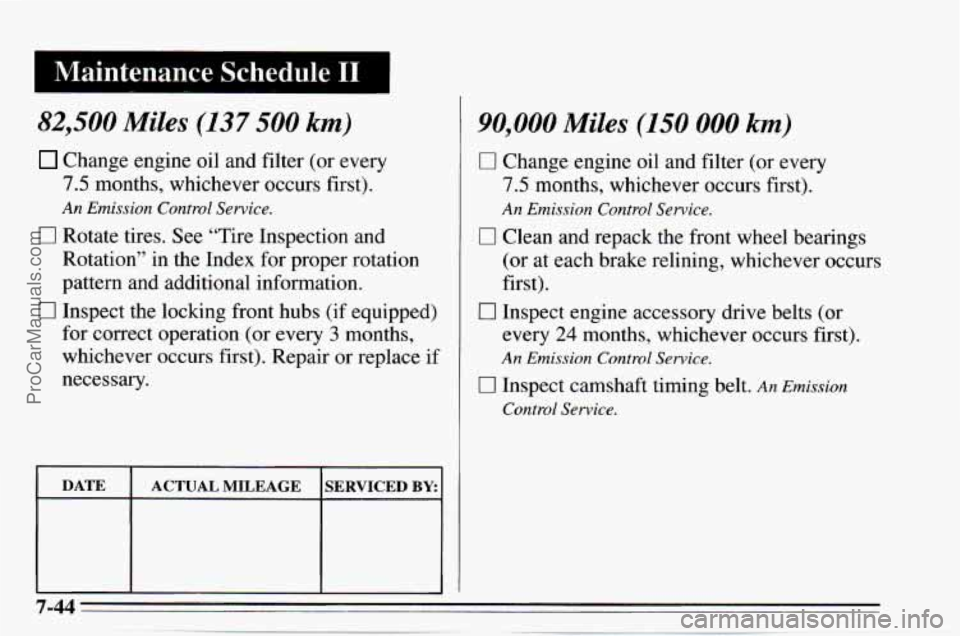
I Maintenance Schedule I1 I
82,500 Miles (137 500 km)
Change engine oil and filter (or every
7.5 months, whichever occurs first).
0 Rotate tires. See “Tire Inspection and
Rotation” in the Index
for proper rotation
pattern and additional information.
An Emission Control Service.
0 Inspect the locking front hubs (if equipped)
for correct operation (or every
3 months,
whichever occurs first). Repair or replace if
necessary.
90,000 Miles (150 000 km)
0 Change engine oil and filter (or every
7.5 months, whichever occurs first).
An Emission Control Service.
0 Clean and repack the front wheel bearings
(or at each brake relining, whichever occurs
first).
every
24 months, whichever occurs first).
0 Inspect engine accessory drive belts (or
An Emission Control Service.
0 Inspect camshaft timing belt, An Emission
Control Service.
ProCarManuals.com
Page 322 of 354
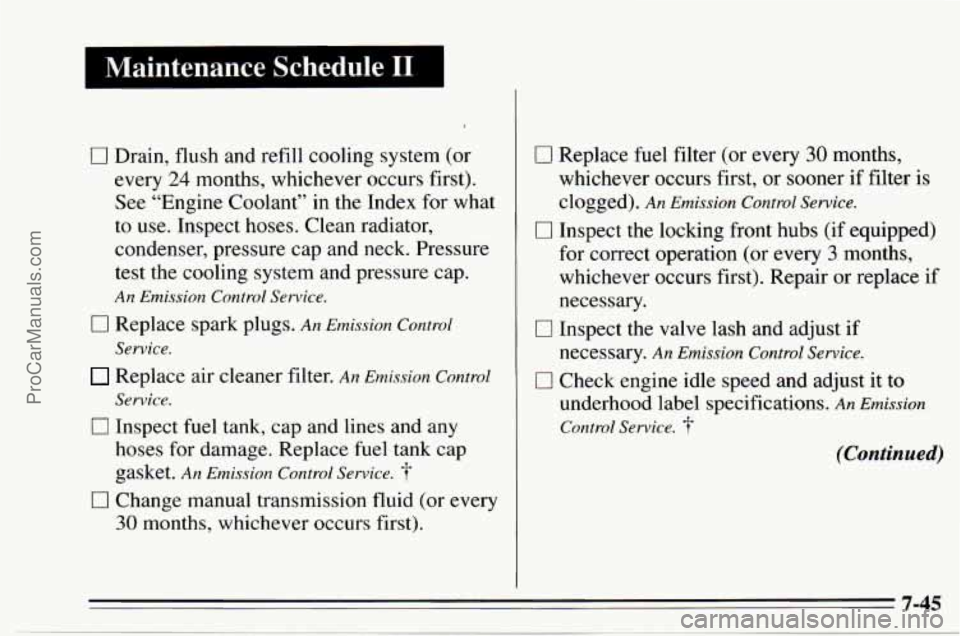
I Maintenance Schedule I1 I
0 Drain, flush and refill cooling system (or
every
24 months, whichever occurs first).
See “Engine Coolant” in the Index for what
to use. Inspect hoses. Clean radiator,
condenser, pressure cap and neck. Pressure
test the cooling system and pressure cap.
An Emission Control Service.
0 Replace spark plugs. An Emission Control
Replace air cleaner filter. An Emission Control
0 Inspect fuel tank, cap and lines and any
Service.
Service.
hoses for damage. Replace fuel tank cap
gasket.
An Emission Control Service.
0 Change manual transmission fluid (or every
30 months, whichever occurs first).
0 Replace fuel filter (or every 30 months,
whichever occurs first,
or sooner if filter is
clogged).
An Emission Control Service.
I7 Inspect the locking front hubs (if equipped)
for correct operation (or every
3 months,
whichever occurs first). Repair or replace if
necessary.
0 Inspect the valve lash and adjust if
necessary.
An Emission Control Service.
0 Check engine idle speed and adjust it to
underhood label specifications. An Emission
Control Service.
T
(Continued)
ProCarManuals.com
Page 323 of 354
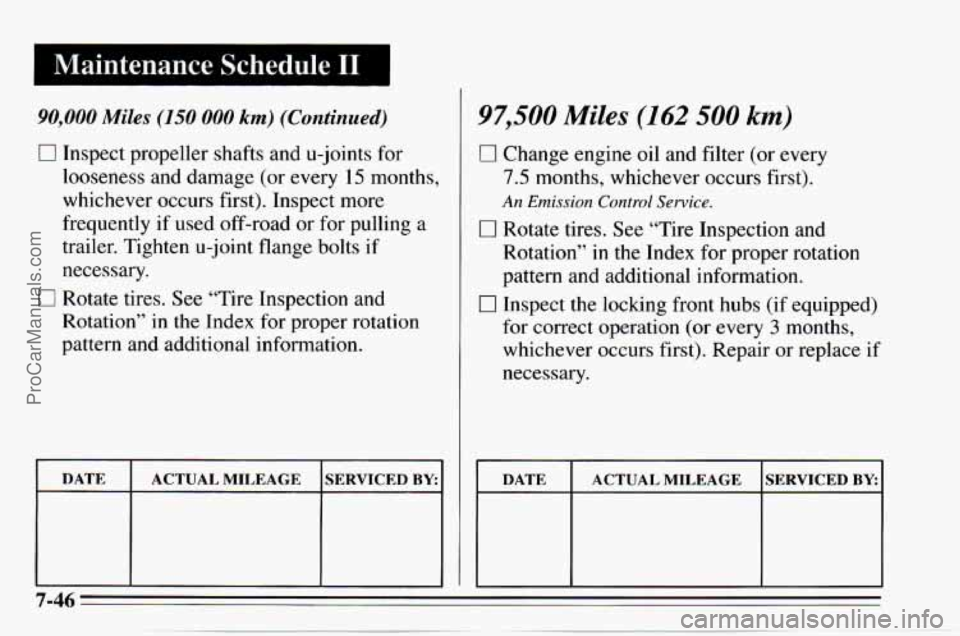
Maintenance Schedule I1 I
90,000 Miles (150 000 km) (Continued)
0 Inspect propeller shafts and u-joints for
looseness and damage (or every
15 months,
whichever occurs first). Inspect more
frequently
if used off-road or for pulling a
trailer. Tighten u-joint flange bolts
if
necessary.
0 Rotate tires. See “Tire Inspection and
Rotation”
in the Index for proper rotation
pattern and additional informati.on.
DATE SERVICED BY ACTUAL MILEAGE
97,500 Miles (162 500 km)
0 Change engine oil and filter (or every
7.5 months, whichever occurs first).
0 Rotate tires. See “Tire Inspection and
Rotation”
in the Index for proper rotation
pattern and additional information.
0 Inspect the locking front hubs (if equipped)
for correct operation (or every
3 months,
whichever occurs first). Repair or replace if
necessary.
An Emission Control Service.
DATE ACTUAL MILEAGE SERVICED BY
7-46
ProCarManuals.com
Page 324 of 354
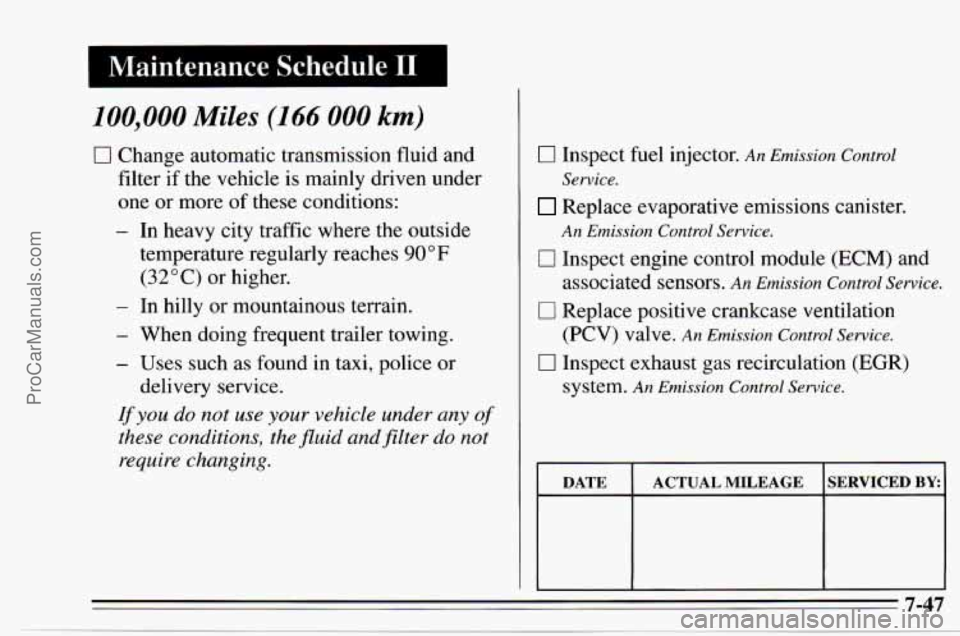
100,000 Miles (1 66 000 km)
17 Change automatic transmission fluid and
filter
if the vehicle is mainly driven under
one or more of these conditions:
- In heavy city traffic where the outside
temperature regularly reaches
90 O F
(32°C) or higher.
- In hilly or mountainous terrain.
- When doing frequent trailer towing.
- Uses such as found in taxi, police or
If you do not use your vehicle under any of
these conditions, ;he fluid and filter do not
require changing.
delivery service.
0 Inspect fu
Service.
el injector. An Emission Control
Replace evaporative emissions canister.
0 Inspect engine control module (ECM) ana
An Emission Control Service.
associated sensors. An Emission Control Service.
0 Replace positive crankcase ventilation
(PCV) valve.
An Emission Control Service.
0 Inspect exhaust gas recirculation (EGR)
system.
An Emission Control Service.
DATE SERVICED BY ACTUAL MILEAGE
7-47
ProCarManuals.com
Page 325 of 354
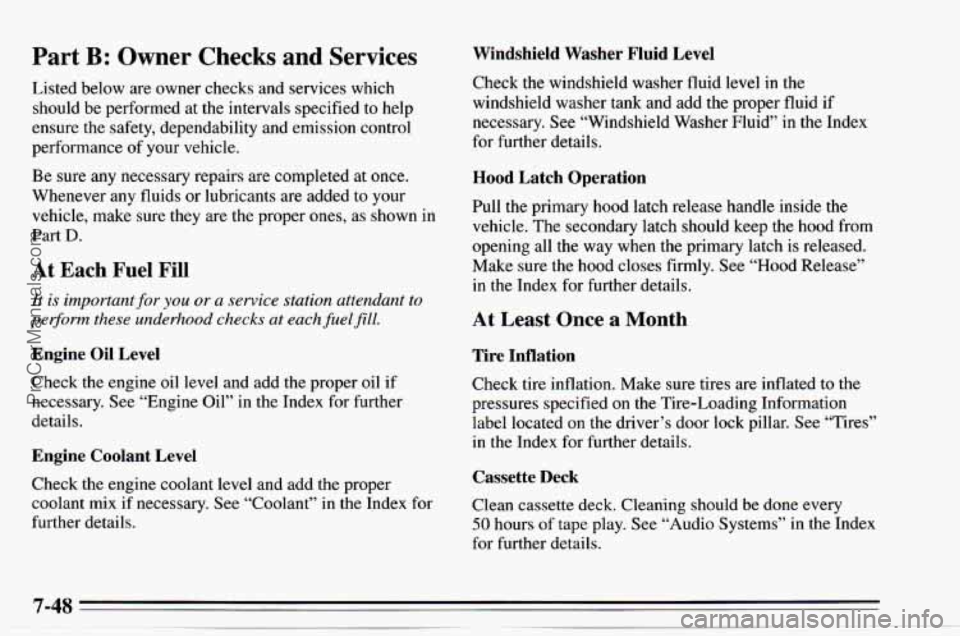
Part B: Owner Checks and Services
Listed below are owner checks and services which
should be performed at the intervals specified to help
ensure the safety, dependability and emission control
performance
of your vehicle.
Be sure any necessary repairs are completed at once.
Whenever any fluids or lubricants are added
to your
vehicle, make sure they are the proper ones, as shown in
Part
D.
At Each Fuel Fill
It is important for you or a service station attendant to
per3cot-m these underhood checks at each fuel fill.
Engine Oil Level
Check the engine oil level and add the proper oil if
necessary. See “Engine Oil” in the Index for further
details.
Engine Coolant Level
Check the engine coolant level and add the proper
coolant mix if necessary. See “Coolant” in the Index for
further details.
Windshield Washer Fluid Level
Check the windshield washer fluid level in the
windshield washer tank and add the proper fluid if
necessary. See “Windshield Washer Fluid” in the Index
for further details.
Hood Latch Operation
Pull the primary hood latch release handle inside the
vehicle. The secondary latch should keep the hood from
opening all
the way when the primary latch is released.
Make sure the hood closes firmly. See “Hood Release”
in the Index for further details.
At Least Once a Month
Tire Inflation
Check tire inflation. Make sure tires are inflated to the
pressures specified on the Tire-Loading Information
label located on the driver’s door lock pillar. See “Tires”
in the Index for further details.
Cassette Deck
Clean cassette deck. Cleaning should be done every
50 hours of tape play. See “Audio Systems” in the Index
for further details.
ProCarManuals.com
Page 326 of 354
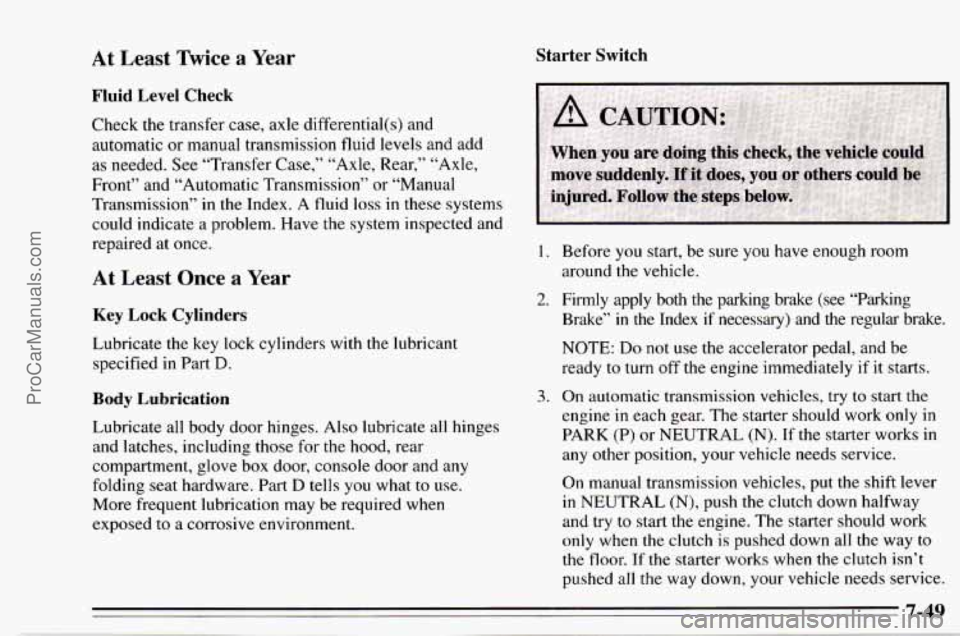
At Least mice a Year Starter Switch
Fluid Level Check
Check the transfer case, axle differential(s) and
automatic or manual transmission fluid levels and add
as needed.
See “Transfer Case,” “Axle, Rear,” “Axle,
Front” and “Automatic Transmission” or “Manual
Transmission” in the Index.
A fluid loss in these systems
could indicate
a problem. Have the system inspected and
repaired at
once.
At Least Once a Year
Key Lock Cylinders
Lubricate the key lock cylinders with the lubricant
specified
in Part D.
Body Lubrication
Lubricate all body door hinges. Also lubricate all hinges
and latches, including those for the hood, rear
compartment, glove box door, console door and any
folding seat hardware. Part
D tells you what to use.
More frequent lubrication may be required when
exposed
to a corrosive environment.
1. Before you start, be sure you have enough room
around the vehicle.
2. Firmly apply both the parking brake (see “Parking
Brake”
in the Index if necessary) and the regular brake.
NOTE:
Do not use the accelerator pedal, and be
ready to turn
off the engine immediately if it starts.
3. On automatic transmission vehicles, try to start the
engine in each gear. The starter should work only in
PARK (P) or NEUTRAL (N). If the starter works in
any other position, your vehicle needs service.
On manual transmission vehicles, put the shift lever
in
NEUTRAL (N), push the clutch down halfway
and try
to start the engine. The starter should work
only when the clutch is pushed down all the way to
the floor. If the starter works when the clutch isn’t
pushed
all the way down, your vehicle needs service.
7-49
ProCarManuals.com
Page 327 of 354
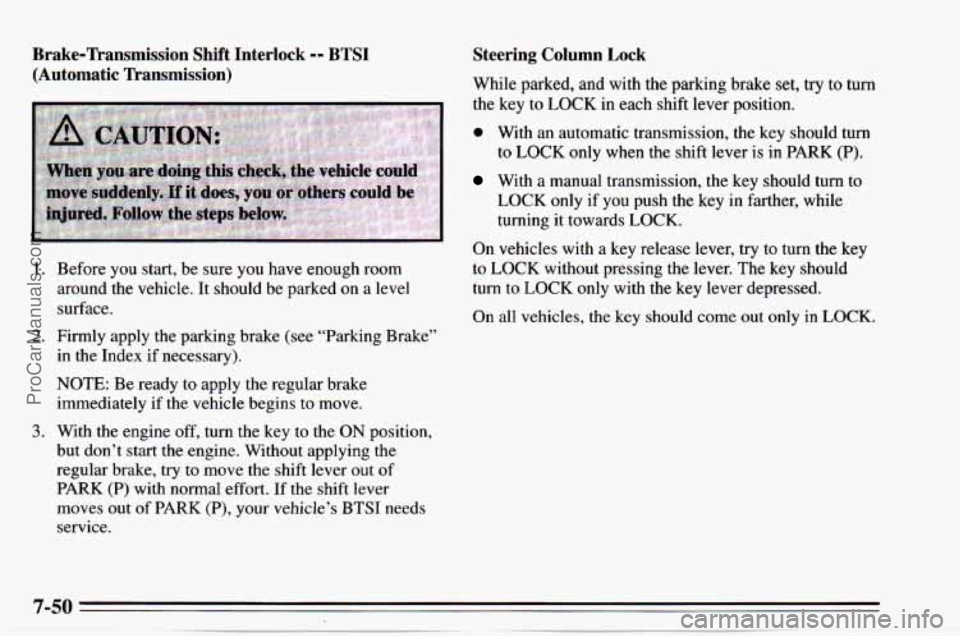
Brake-Transmission Shift Interlock -- BTSI
(Automatic Transmission)
1.
2.
3.
Before you start, be sure you have enough room
around the vehicle. It should be parked on a level
surface.
Firmly apply the parking brake
(see “Parking Brake”
in the Index if necessary).
NOTE: Be ready to apply the regular brake
immediately if the vehicle begins to move.
With the engine off, turn the key
to the ON position,
but don’t start the engine. Without applying the
regular brake, try to move the shift lever out of
PARK
(P) with normal effort. If the shift lever
moves out of PARK (P), your vehicle’s BTSI needs
service.
Steering Column Lock
While parked, and with the parking brake set, try to turn
the key to
LOCK in each shift lever position.
0 With an automatic transmission, the key should turn
to
LOCK only when the shift lever is in PARK (P).
With a manual transmission, the key should turn to
LOCK only if you push the key in farther, while
turning it towards
LOCK.
On vehicles with a key release lever, try to turn the key
to
LOCK without pressing the lever. The key should
turn to
LOCK only with the key lever depressed.
On all vehicles, the key should come out only in LOCK.
ProCarManuals.com
Page 328 of 354
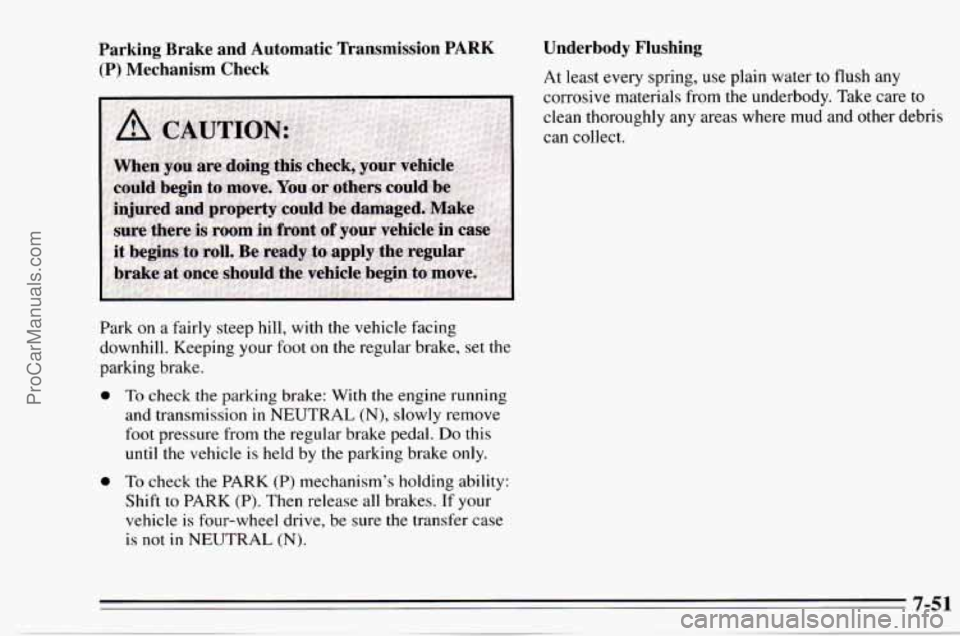
Parking Brake and Automatic Ikansmission PARK Underbody Flushing \
(P) Mechanism Check At least every spring, use plain water to flush any
corrosive materials from
the underbody. Take care to
clean thoroughly any areas where mud and other debris
can collect.
.-
Park on a fairly steep hill, with the vehicle facing
downhill. Keeping your foot
on the regular brake, set the
parking brake.
0 To check the parking brake: With the engine running
and transmission
in NEUTRAL (N), slowly remove
foot pressure from the regular brake pedal.
Do this
until the vehicle is held by the parking brake only.
0 To check the PARK (P) mechanism's holding ability:
Shift to
PARK (P). Then release all brakes. If your
vehicle is four-wheel drive, be sure the transfer case
is not in NEUTRAL (N).
ProCarManuals.com
Page 329 of 354
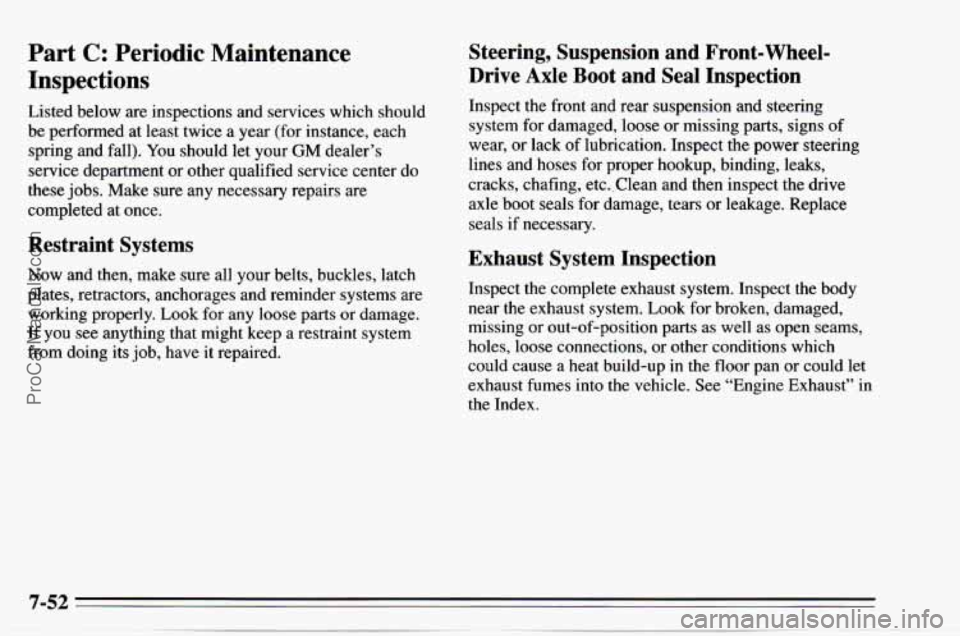
Part C: Periodic Maintenance
Inspections
Listed below are inspections and services which should
be performed
at least twice a year (for instance, each
spring and fall). You should let your GM dealer’s
service department or other qualified service center do
these
jobs. Make sure any necessary repairs are
completed at once.
Restraint Systems
Now and then, make sure all your belts, buckles, latch
plates, retractors, anchorages and reminder systems are
working properly. Look for any loose parts or damage.
If you see anything that might keep a restraint system
from doing its job, have it repaired.
Steering, Suspension and Front-Wheel-
Drive Axle Boot and Seal Inspection
Inspect the front and rear suspension and steering
system for damaged, loose or missing parts, signs of
wear, or lack of lubrication. Inspect the power steering
lines and hoses for proper hookup, binding, leaks,
cracks, chafing, etc.,Clean and then inspect the drive
axle boot seals for damage, tears or leakage. Replace
seals
if necessary.
Exhaust System Inspection
Inspect the complete exhaust system. Inspect the body
near the exhaust system.
Look for broken, damaged,
missing or out-of-position parts as well as open seams,
holes, loose connections, or other conditions which
could cause
a heat build-up in the floor pan or could let
exhaust fumes into the vehicle. See “Engine Exhaust” in
the Index.
ProCarManuals.com
Page 330 of 354
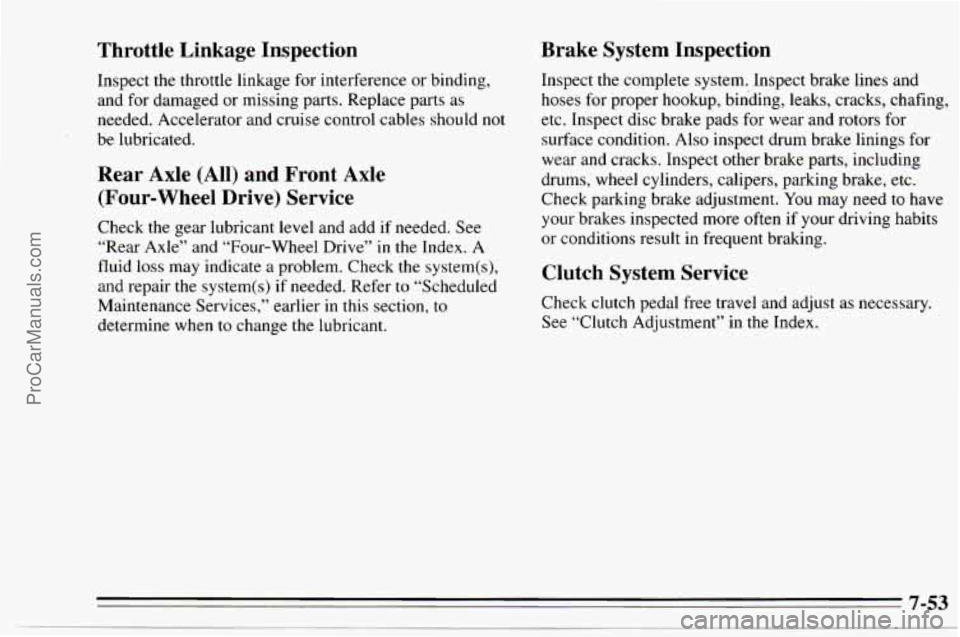
Throttle Linkage Inspection
Inspect the throttle linkage for interference or binding,
and for damaged or missing parts. Replace parts as
needed. Accelerator and cruise control cables should
not
be lubricated.
Rear Axle (All) and Front Axle
(Four-Wheel Drive) Service
Check the gear lubricant level and add if needed. See
“Rear Axle” and “Four-Wheel Drive”
in the Index. A
fluid loss may indicate a problem. Check the system(s),
and repair the system(s) if needed. Refer
to “Scheduled
Maintenance Services,” earlier
in this section, to
determine when to change the lubricant.
Brake System Inspection
Inspect the complete system. Inspect brake lines and
hoses for proper hookup, binding, leaks, cracks, chafing,
etc. Inspect disc brake pads for wear and rotors for
surface condition. Also inspect drum brake linings for
wear and cracks. Inspect other brake parts, including
drums, wheel cylinders, calipers, parking brake, etc.
Check parking brake adjustment.
You may need to have
your brakes inspected more often if your driving habits
or conditions result in frequent braking.
Clutch System Service
Check clutch pedal free travel and adjust as necessary.
See “Clutch Adjustment’’ in
the Index.
7-53
ProCarManuals.com